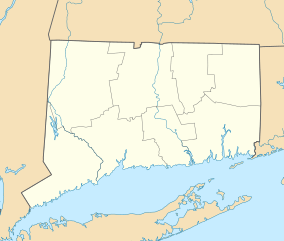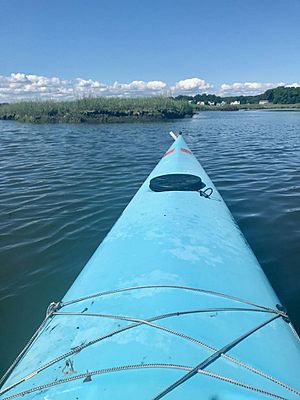Charles E. Wheeler Wildlife Management Area facts for kids
Quick facts for kids Charles E. Wheeler Wildlife Management Area |
|
|---|---|

Swans at high tide in Charles E. Wheeler WMA
|
|
| Location | Devon, Milford, New Haven, Connecticut, United States |
| Nearest city | Milford |
| Area | 625 acres (253 ha) |
| Website | Charles E. Wheeler Wildlife Management Area Facebook Page |
The Charles E. Wheeler Wildlife Management Area is a special place in Milford, Connecticut. It's a 625-acre area of marshland, owned by the state. It's a nature preserve where you can see wildlife, and it's also a place for hunting.
This area is located on the eastern side of the Housatonic River's mouth, near Milford. A natural sand barrier called Milford Point protects it from Long Island Sound. The main part of the Housatonic River flows west of the area. But a lot of river water also flows into and through the marsh, especially with the tides.
Contents
Plants of the Marsh
Most of the marshlands here are covered with plants. This is true whether they are covered by water at high tide or exposed. The main plants you'll find are two types of cordgrass. One is called smooth cordgrass (Spartina alterniflora). The other is saltmeadow cordgrass (Spartina patens). These grasses are very important for the marsh environment.
Animals of the Marsh
The Charles E. Wheeler Wildlife Management Area is a very important stop for migratory birds. Many birds stop here during their long journeys, especially shorebirds. It's also a safe place for ducks, geese, swans, and many other birds. Besides birds, you can find insects, crabs, fish, and even some mammals living in the marsh.
Fun Activities to Do
You can enjoy many activities in the Charles E. Wheeler Wildlife Management Area. These include hunting, fishing, bird watching, photography, and boating.
Hunting and Fishing Rules
- Hunting is only allowed for waterfowl (like ducks and geese).
- You need special permits to hunt, and it's only allowed during certain seasons.
- Fishing is also a popular activity here.
Boating in the Marsh
- You can use both motorized and non-motorized boats.
- Kayaks, canoes, stand-up paddleboards (SUPs), and rowboats are popular.
- These smaller boats are good for moving through the narrow creeks and channels.
Safety Tips for Visitors
It's important to be careful when visiting the marsh by boat:
- Watch the Tides: You need to know when high tide is. This is crucial for entering and leaving the marsh by water.
- Don't Get Lost: The marsh has many winding passages. It's easy to get lost and miss the time when the tide is high enough to leave.
- Strong Currents: The powerful tides can create strong currents in some narrow parts of the marsh.
- Best Time to Go: The best time to explore the marsh by boat is at or just before high tide.
- Mud Flats: Many waterways inside the marsh become mud flats at low tide. These are very hard to cross.
How to Get There
You can usually only get into the Charles E. Wheeler Wildlife Management Area by water. However, there are several places on shore where you can view the marsh. These include Milford Point, the Connecticut Audubon Society Coastal Center, or "Nancy's Meadow."
Boat Launch Locations
If you want to launch a boat, here are some nearby places:
- Closest Launch: The easiest access is an unpaved state boat launch. It's at the end of Court Street in Milford. This launch is run by the Connecticut Department of Energy and Environmental Protection.
- Limited Access: There's a small public access spot at the end of Deerwood Avenue in Milford. It has no dedicated parking.
- Housatonic River Launch: About half a mile north of the marsh is the Housatonic River State Boat Launch. It's under the I-95 bridge at the end of Naugatuck Avenue in Milford.
You are not allowed to launch boats from the Connecticut Audubon Society Coastal Center. Also, launching from the Stewart B. McKinney National Wildlife Refuge Milford Point Unit is difficult because there's no public road access.
Boating Speed Rules
There are rules about how fast you can go in your boat in the Charles E. Wheeler Wildlife Management Area. These rules are part of the Connecticut State Agencies regulations.
- You must go "Slow No Wake" in the channel east of Nells Island.
- This rule also applies to all channels, creeks, and waterways within the Charles E. Wheeler Wildlife Management Area, including around Nells Island. "Slow No Wake" means going slow enough so your boat doesn't create a large wave.
Islands and Nearby Places
Several islands are part of the Charles E. Wheeler Wildlife Management Area:
- Duck Island
- Nells Island
The Connecticut Audubon Society Coastal Center at Milford Point is next to the marsh. It teaches people about nature and wildlife, especially migratory birds. It has displays, educational programs, and trails. You can also find an observation tower and deck there.
Milford Point is a curved beach that protects the marsh. It is part of the Stewart B. McKinney National Wildlife Refuge. This refuge is very important for migratory birds. Most of Milford Point is protected from people for much of the year. This helps protect nesting areas for the Piping plover, which is a threatened bird species.
History of the Area
The Charles E. Wheeler Wildlife Management Area is named after Charles E. "Shang" Wheeler (1872-1949). He was a very interesting person from Connecticut.
Who Was Charles "Shang" Wheeler?
- He was a state senator and representative.
- He loved the outdoors and worked to protect nature.
- He was also a famous amateur artist who carved wooden duck decoys.
- He managed the Connecticut Oyster Farms Company for many years.
- He was known as a great football player, boxer, and fly caster.
- He was also an expert on oysters.
Shang Wheeler was born in Westport and lived in Stratford. He served in the Connecticut House of Representatives and the Connecticut State Senate.
How the Area Got Its Name
- In 1953, a special law put Nell's Island under the control of the State Board of Fisheries and Game.
- Then, in 1955, another special law changed the name of Nell's Island to the Charles E. Wheeler Wildlife Management Area.
- It was named after him because of his important work in conservation. He helped protect the wetlands at the mouth of the Housatonic River.
- He also helped raise money in 1935 to improve a research lab in Milford Harbor. This lab studied shellfish in Long Island Sound. A research boat used by the lab was even named the R/V Shang Wheeler!
Protecting the River
By 1950, the Housatonic River near the marsh was in danger of filling up with dirt and sand. This is called "silting in." People worried it would block boats. In 1950, business leaders and conservation groups asked the U.S. government to fund a project to dredge the river. Dredging means digging out the bottom of the river to make it deeper. They also asked that the dredged material not be dumped into the marshlands.
The Housatonic River channel was dredged in 1976 and again in 2012. This was done to keep the marshlands from growing too much into the main river channel. This helps keep the river open for boats.
Images for kids





